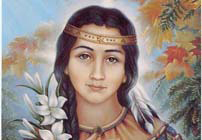BIRCH ISLAND––It has been a long journey for a determined local group of devotees, many of whom have since passed on to the spirit world, unable to witness the fruition of their efforts, but those left behind take heart in the news that the Blessed Virgin Kateri Tekakwitha, the Flower of the Algonquins and Lily of the Mohawks, will finally receive her due on October 21.
A group of Anishinaabe devotees of the Blessed Kateri will be on hand for the canonization, including an audience with Pope Benedict on October 24. Dianne Musgrove of Birch Island will be among the group of 70 from Manitoulin and the North Shore going to Rome as a group.
“I am beyond excited,” said Ms. Musgrove, who noted that traveling along with the group will be Sister Kateri of Wikwemikong. “How wonderful is that?” she asked.
“Reverend Frank Wagner of St. Anne’s in Sudbury got us a great deal,” said Ms. Musgrove, who will be staying in a convent a mere 15 minutes from the Vatican in Rome. Many of the other Island faithful will also be staying in the same place.
Ms. Musgrove has agreed to keep a daily travel diary of hers and the other Island pilgrims’ experiences while on the pilgrimage to the canonization of the Blessed Kateri and send those observations to The Expositor. The Expositor will post her diary on our website manitoulin.ca as postings arrive.
The tour will take in a prayer vigil at St. John Lateran Basilica on October 20, the canonization in St. Peter’s Basilica on October 21, a Thanksgiving Mass at the Basilica, a pilgrimage to Assisi and the papal audience at the Vatican.
The tour returns to Canada on October 26.
The Blessed Kateri is the first indigenous North American to be canonized as a saint. There are a number of stages to becoming a saint, and those stages can span centuries. In the case of the Blessed Kateri the delay has been even longer than usual because of politics and the strange vagaries of international boundaries.
“It’s about time,” said Jean McGregor Andrews of Whitefish River First Nation. “I think it has been a long time coming.”
Ms. McGregor Andrews and musician Lawrence Andrews, also of Birch Island, travelled across the country in the 1980s with a musical prayer ministry dedicated to the Blessed Kateri. Mr. Andrews played the guitar and the group sang at gatherings on reserves stretching from Alberta to Montreal and into the United States.
“I had a Suburban and about half a dozen people would climb in there and there was a van and some cars,” said Ms. Andrews. “There was a deacon from Batchewana named Murray Sayer and we would travel to reserves in Thunder Bay and Kahnewaki by Montreal.” Ms. Musgrove’s late mother Rose Dooley of Little Current was a part of this group.
Mr. Andrews noted that the process of obtaining sainthood is a long and complex affair. “I guess it is coming pretty close now,” he said. “They have to find miracles that don’t have another excuse. If someone is cured of cancer, say, they might say it was because of the stuff they were taking that they got better. It has to be clear.”
The prayer group would often perform songs, many dedicated to the Blessed Kateri, and written by another Northern deacon in the Catholic Church, Richard Sayers.
Ms. Musgrove recalled her own experiences with the Kateri Music Ministry. “When I was here I went out with them to sing,” she said. Ms. Musgrove recalled that the Kateri group was part of the Charismatic movement that was sweeping the Roman Catholic Church at the time.
“I am not sure how much impact the sainthood will have now,” she said. “A lot of interest has waned, especially among the youth.” Ms. Musgrove noted that the adherents of the Blessed Kateri are now strongest south of the American border and in Latin America. “They refer to her as ‘Amerind’,” she noted. “I think it is important to the church to have someone from the Americas people can identify with as from these continents.”
The Blessed Kateri was barely 24-years-old when her life was snuffed out, scarred and half blind from the smallpox epidemic which had swept through the Mohawk village and taken her parents’ lives while she lay delirious with fever in the next chamber. But legend has it that the disfigured face of the young virgin woman who had given up her life to chastity and the service of the Christian God was transformed at the moment of death into radiant beauty.
So beautiful were the mortal remains of the young woman that two passing voyageurs, upon later learning that she was indeed dead, returned to volunteer to build her coffin. It was the first of many miracles that would be attributed to the Blessed Virgin Kateri Tekakwitha, the Lily of the Mohawks, Flower of the Algonquins.
It was April 17, 1680 when the Blessed Kateri began her spirit journey while serving the First Nation Catholic community of Kahnawaki, Quebec—the nations of Canada and the United States of America were yet to be created. She had fled there under persecution from the traditional followers in her home community, which now lies in the state of New York.
Throughout her life, war was endemic on the land, her mother was an Algonquin Christian, kidnapped following the murder of her family in an Iroquois raid on Trois Rivieres. The Iroquois were allies of the British who were in a struggle with the French for dominance in Europe and for the lucrative fur trade in what was to become known as North America.
The Blessed Kateri’s mother later married her captor and bore him a son and a daughter. The son and the Blessed Kateri’s parents succumbed to a smallpox epidemic, but before she died, the Blessed Kateri’s mother instilled the Christian faith in her. After she recovered from her illness, a great Mohawk chief, an uncle of her father, adopted her as his own.
As the daughter of an influential chief, the Blessed Kateri found herself the focus of many suitors despite her disfigurement and blindness. Outraged by the hypocrisy of those suits, the young virgin vowed to have no husband and to remain celibate. This ran counter to the proper conduct of a young Mohawk woman of high status and she became persecuted by her family and community.
Kateri was baptized at the age of 20 and spent the next four years caring for the poor and sick. Upon her death, her disfigurement was said to have disappeared.
Although the process of canonization began 200 years following her death in 1680, it was only in 1943 that Pope Pius the XII declared that transformation to have been a true miracle and declared her to be ‘venerable’—the first stage on the road to sainthood.
It took nearly 40 years more before she was beatified on June 22, 1980.
Things sped up once another miracle was certified by the Catholic Church to have occurred through her intercession last year. At that point she became the Blessed Kateri and plans began for her full canonization as a saint in the Roman Catholic pantheon, becoming the very first First Nation saint.
“There were a lot of Native people who prayed for help from the Blessed Kateri—a lot of people who have been healed,” said Ms. McGregor Andrews. “But a lot of people are not the kind to make a lot of noise about it. They don’t go out and publicize it.”
Many attribute the delay in recognition of her sainthood to the difficulties inherent in determining ‘ownership’ of the saint. Born in what is now the United States of a Canadian Algonquin mother, albeit conceived in the US with an ‘American’ Mohawk father (many of the Mohawks were later forced out of the US as British loyalists and some of their reserves still straddle the border), the Blessed Kateri is claimed by both political jurisdictions that did not even exist at the time of her birth or death.
There are some in the church (those outside the Roman Catholic Church don’t usually give it much thought) who suggest that the recent uncharacteristically precipitous moves by the church hierarchy to finally canonize the first Native saint have been motivated by the decline of the church in general and the perception that First Nation communities and Latin America may prove to be fertile ground for the expansion of the church into those communities. Others point out that the process of becoming a saint is not influenced by such mundane matters of politics and geography, but rather guided by a strict set of rules that can literally take centuries to fulfill and that it has simply become the Blessed Kateri’s time to be recognized.
In any event, the process has certainly taken its own time in unfolding and most accept that it is time for her to take her place as a Roman Catholic saint.
Despite her lack of canonization, the Blessed Kateri was once the patroness of Montreal and there are a number of statues and shrines dedicated to her in Canada, the United States and Mexico.
For her adherents, however, the canonization of the Blessed Kateris Tekakwitha, whether the Lily of the Mohawks or the Flower of the Algonquins, is long past due.
“She deserves that honour,” said Ms. McGregor Andrews. “She has made a lot of changes in people’s lives. People need that today, especially people struggling with alcohol and drug addictions and young people.”





